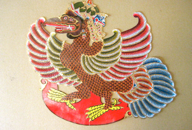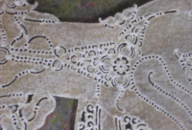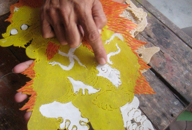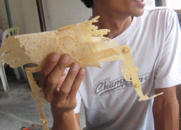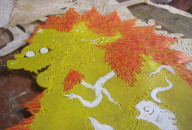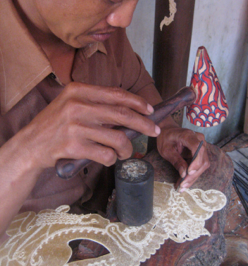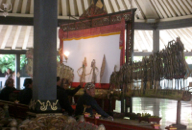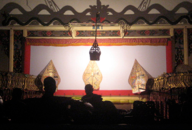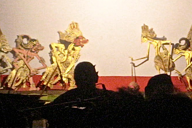Wayang Kulit
Traditional Indonesia Puppets
Within the walls of the keraton
Yogyakarta, central java, indonesia
April 11, 2009


Wayang Kulit
Traditional Indonesia Puppets
Within the walls of the keraton
Yogyakarta, central java, indonesia
April 11, 2009




While touring the Keraton, Nona, our guide, suggested that Henry and I see the Wayang Kulit puppet maker’s workshop in the adjoining staff compound. We were escorted through the back alley of the palace to find a small building where the puppet makers worked. The workshop bore the name R. Moerdijato. This is the master puppet maker, now spiritual adviser to the sultan. He is also the father of the two craftsmen we met, the current generation in a line of ten generations of master craftsman in Wayang Kulit, a revered status in Indonesian society. The puppets are used in shadow puppet plays, performances of Ramayana and Mahabharata Hindu epics, which impart complex subtle lessons in social behavior. As one of the brothers worked chiseling a fine lacework design in the buffalo hide, the other brother explained how the puppets were made. The hide, from which the puppet parts and shapes are cut, is of superior leather, lasting more than 100 years. It can be bent, rolled, but not destroyed. Some of the earliest puppets made by this family are still used in performances. After the shapes are cut from templates and assembled, the patterns which determine the costumes, the expressions, and the qualities and personalities of these puppets are carefully embossed with fine-pointed chisels, tapped into the leather with a mallet. The chisels we saw had been made by R. Moerdijato, fashioned from the spokes of a motorcycle. The craftsman works slowly and carefully, creating an intricate surface. The next stage in puppet making is painting the surfaces of the puppet, both sides, enabling the character to be flipped by the puppeteer. Our guide, the painter of Wayang Kulit puppets, explained that all the colors used are handmade from the dried pigments obtained from plants, or minerals obtained from stone. The puppets first receive an underpainting, then the details of the puppet’s clothing, facial expressions and personalities are added in. We were shown an array of completed puppets, beautifully painted. To complete our puppet experience, Henry and I saw two puppet shows, each different. The first, a performance at the Sultan’s Palace, used the puppets as shadow puppets worked from behind the fixed screen where the puppeteers sat, hidden from the audience. The gamelan orchestra, which accompanied the drama, sat behind the screen as well, intently watching and responding with their percussion music to the theater of the Wuyang Kulit play. Later that evening, Henry and I arrived at another theater in the heart of Yogyakarta for an epic enactment of Wuyang Kulit. This was a special performance which occurred only on the second Saturday of each month. It began at 9 PM, and lasted eight hours through night, ending at 5 AM. The attendees, Indonesians from all walks of life, including men, women, and children, came ready to stay the duration, bringing food, drink, and plenty of cigarettes to keep themselves awake and engaged. This performance was set up with the large screen facing the audience, with long rows of flat puppets on their sticks, arranged in order of size both right and left of the screen. A light hung in the center of the stage, and the puppeteer sat slightly behind it, manipulating the puppets from the front of the screen, casting shadows on the white screen itself. This was very interesting, because the audience was able to clearly see the beautifully painted puppets. The gamelan orchestral also sat on stage, their backs to the audience, with their attention placed on the performance and the puppeteer. A group of women, sitting on stage facing the audience, provided female vocalists as voices to the musical accompaniment. Henry and I were both amused as we watched little boxed dinners being passed amongst the musicians and singers. After an hour, of watching a slow moving unfolding of the epic tale, we returned to our hotel still mystified, but with our curiosity quite satisfied.
PHOTOS: Left Column: 1. Puppet maker in the family studio. 2. Name of the master Wuyang Kulit puppet maker, posted above he doorway. 3. The painter of puppets, explaining the composition of the pigments. 4. A puppet rolled into a cylinder, a demonstration of the flexibility of the buffalo hide, from which these puppets are made. 5. Wuyang Kulit puppet performance at the Sultan’s palace. Here the puppets were worked behind the screen, casting shadows for the audience to see. 6. A view of the performance at the puppet pavilion at the Sultan’s palace. Center, Top: Mujiono, working with chisel and mallet on one of the Wuyang Kulit puppets. Center, Middle: The puppet on the workbench. Center, Bottom: A completed Wuyang Kulit puppet. Right Column: 1. A chisel (made from a motocycle spoke) pointing out the delicate design impressed into the shaped buffalo hide. 2. Detail: the lace-like design on the Wuyang Kulit puppet. This view shows a flower opening, representing the heart center. 3. A view of the underpainting on one of the puppets, a work in process. 4. Garuda, a puppet designed by R. Moerdijanto, Wuyang Kulit puppet master. It is a great honor and accomplishment to have designed a puppet. Garuda is a very powerful character in Hindu mythology, representing the visions, hopes, and dreams of all of us. 5. The stage set for the all-night Wuyang Kulit performance. 6. Puppets being manipulated before the screen by the puppeteer during the epic performance in Yogyakarta.


A TREASURE OF INDONESIAN CULTURE
